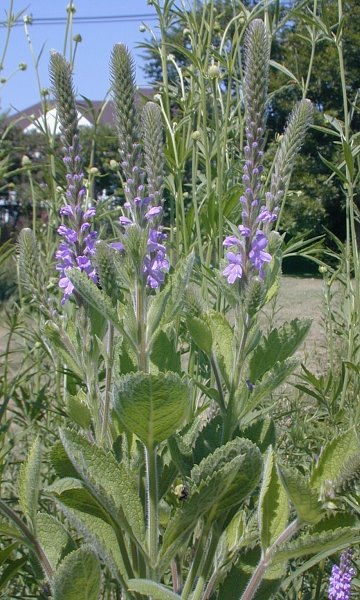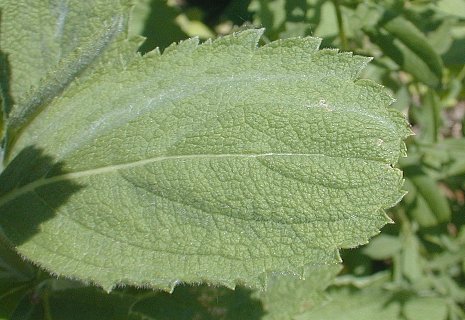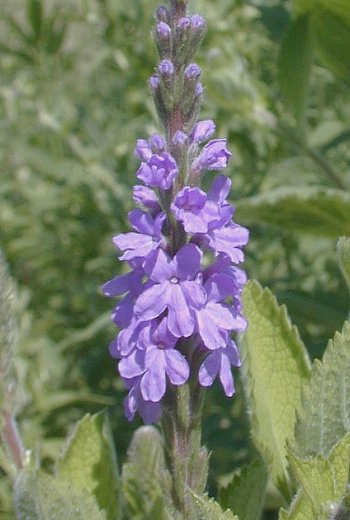Description: This short-lived perennial plant is up to 3½' tall, branching occasionally. The stems are light green to dull reddish purple and they are heavily covered with long white hairs. The opposite leaves are up to 4" long and 3" across; they are oval-ovate or obovate and coarsely serrated along the margins. The whitish green leaves are covered with fine white hairs (especially on their lower sides), and they are either sessile or have short petioles. In addition to the pinnate venation, each leaf has a reticulated network of smaller veins. The upper stems terminate in hairy floral spikes. These spikes are 1-8" long and densely crowded with pink or lavender flowers (usually the latter). The floral spikes bloom from the bottom up; relatively few flowers are in bloom at the same time. Each flower is about ¼" across or a little wider, consisting of a short corolla with a narrow opening and 5 spreading lobes, a small calyx with narrow teeth, and the reproductive organs. The calyx is grayish green to reddish purple and hairy. There is no floral scent. The blooming period occurs from mid- to late summer, and lasts about 1½ months. Four brown nutlets are produced per flower. The root system consists of a taproot, which may tiller from the base (sending up multiple stems). This plant reproduces by reseeding itself.

Cultivation:
The preference is full sun and mesic to dry conditions. Generally,
Hoary Vervain flourishes in poor soil containing some clay, sand, or
gravel. In rich loamy soil, it will grow well, but has difficulty
competing with other plants. Drought resistance is good, although some
of the lower leaves may shrivel and fall off the plant. The seeds
germinate readily in open areas where there is some exposure to
sunlight.
Range & Habitat:
The native Hoary Vervain occurs in almost every county of Illinois. It
is fairly common, although possibly less so than in the past (see Distribution
Map). Habitats include upland prairies, gravel prairies, hill
prairies, barrens with stunted shrubby vegetation, limestone glades,
overgrazed pastures, abandoned fields, the grassy shoulders of highway
overpasses, and areas along railroads. Hoary Vervain favors low grassy
areas with a history of disturbance, particularly from grazing.

Faunal Associations: Many kinds of insects are attracted to the flowers, including long-tongued bees, green metallic bees, thread-waisted wasps, bee flies, thick-headed flies, butterflies, and skippers. Among the long-tongued bees, the flowers attract such visitors as honeybees, bumblebees, little carpenter bees, cuckoo bees (Triepeolus spp.), miner bees (Melissodes spp.), and leaf-cutting bees (Megachile spp.). A specialist visitor of the flowers is Calliopsis verbenae (Verbena Bee). Several grasshoppers feed on the foliage of Hoary Vervain: Hippiscus ocelote (Wrinkled Grasshopper), Melanoplus confusus (Little Pasture Grasshopper), Melanoplus femurrubrum (Red-Legged Grasshopper), and Melanoplus keeleri luridus (Keeler's Grasshopper). Other insect feeders include caterpillars of the moth Catabena lineolata (Fine-Lined Sallow), caterpillars of Crambodes talidiformis (Verbena Moth), and the aphid Macrosiphum verbenae. The seeds of Verbena spp. are eaten by various songbirds to a limited extent, including the Cardinal (winter), Slate-Colored Junco (winter), Field Sparrow, and others. It is possible that these birds help to distribute the seeds to new areas. Mammalian herbivores rarely eat Hoary Vervain because the foliage is quite hairy and bitter. It is considered an 'increaser' in overgrazed pastures.

Photographic
Location:
The photographs were taken at the webmaster's wildflower garden in
Urbana, Illinois.
Comments:
Among the Verbena spp.
that are native to Illinois, Hoary Vervain is one of the showiest, even
though it is sometimes considered an unwelcome weed in pastures. This
vervain can be distinguished from similar species by its larger
flowers and exceptionally hairy stems and leaves. Naturally occurring
hybrids of Hoary Vervain with other Verbena spp. can
occur, although they are relatively uncommon.